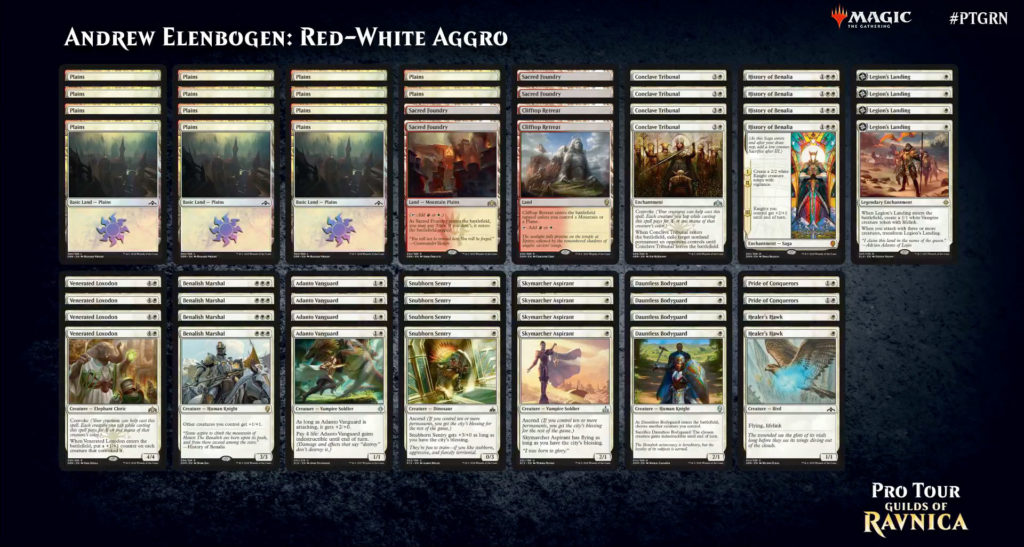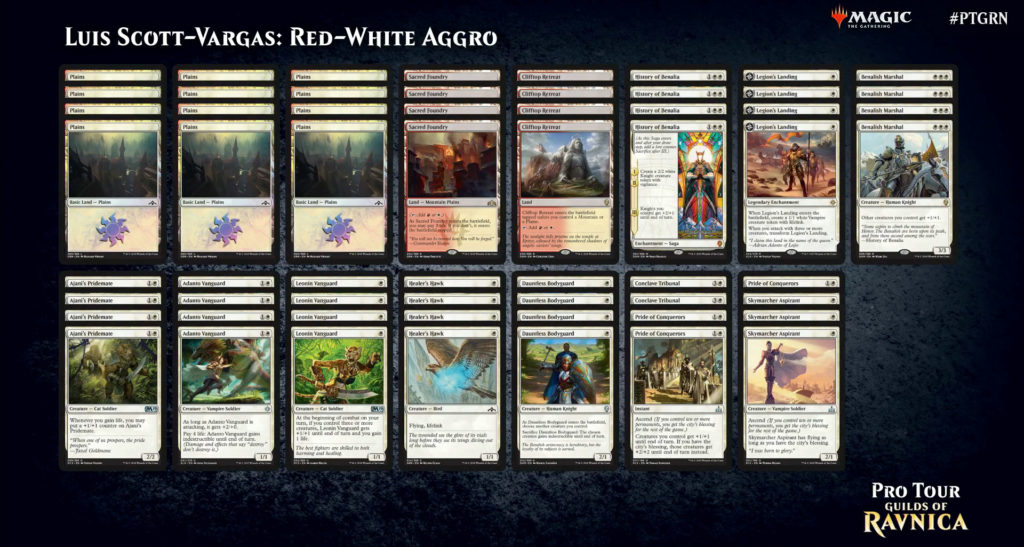In a Top 8 packed with White aggressive decks, Andrew Elenbogen defeated Jeskai Control and two Red-White mirror matches to win Pro Tour Guilds of Ravnica.
Don’t miss our Day 1 and our Day 2 recaps.
Two Takes on White Weenie in the Finals
Elenbogen met Luis Scott-Vargas in the finals in what looked like, based on archetype, a Red-White Aggro mirror match. But, outside of Plains, History of Benalia, and Benalish Marshal, Elenbogen and Scott-Vargas brought two different takes on Red-White aggro to the finals.

Elenbogen was basically alone in the tournament in including four copies each of Venerated Loxodon and Snubhorn Sentry. He also chose to include four copies of Conclave Tribunal, rather than the two that most other White lists played.

Scott-Vargas, and the other members of Team ChannelFireball, included a lifegain package in their take on Red-White aggro. The innovation of including four copies of each Leonin Vanguard and Healer’s Hawk, on top of the usual four copies of Legion’s Landing, giving the deck enough repeatable lifegain to create huge Ajani’s Pridemates. Those Pridemates gave Scott-Vargas a way to go over the top of other Red-White decks—quite impressive for a two-drop—along with enough lifegain to outrace them.
A Exciting Final…Until Game 5
Scott-Vargas, the seventh seed, was on the play in Game 1 over Elenbogen, the eighth seed, and curved out for an easy win. Elenbogen was on the play for Game 2, and curved out for an easy win to tie the match. Scott-Vargas took the play in Game 3 and likewise curved out for an easy win. That put him one game away from a second Pro Tour win but Game 4 followed the established pattern and Elenbogen, on the play, rolled to victory.
In Game 5, Scott-Vargas again found himself on the play and looking to curve out, just like both of the players had done in Games 1 through 4. But he couldn’t find a hand he liked and mulliganed to four cards, while Elenbogen kept seven, and Scott-Vargas never recovered. Elenbogen won easily to become the Pro Tour Guilds of Ravnica Champion.
Dezani Gets Wrecked by LSV
Though Game 5 of the final was anticlimactic, the game that put Scott-Vargas into the finals was full of drama.
Jeremy Dezani, on a more Red-heavy Boros Aggro deck, met Scott-Vargas in the semifinals, both having beat other Red-White aggressive decks in the quarterfinals. Scott-Vargas won two close games to go up 2-0 in the match, but wasn’t an obvious favorite to win Game 3. Dezani, with both Aurelia, Exemplar of Justice and Heroic Reinforcements, was looking to put his foot on the gas and get his first win.
But Scott-Vargas, who was on the back foot, had drawn his only copy of Settle the Wreckage and knew that baiting Dezani into overcommitting to an attack was his best road to victory. Four open mana is an awfully suspicious amount of mana to leave up, as Scott-Vargas was well aware, but he also had an active Adanto, the First Fort. He heavily represented that he would activate Adanto should Dezani attack, even helpfully grabbing a Vampire token for Dezani so he could map out the blocks Scott-Vargas would make. After Dezani was satisfied that he could make an advantageous attack, even in the face of an Adanto, the First Fort activation, he pushed all of his creatures into the red zone—and Scott-Vargas casually flipped his Settle the Wreckage onto the table.
As if that wasn’t entertaining enough, Scott-Vargas said that he only included Settle the Wreckage in his sideboard because Team ChannelFireball wanted to include a single copy in only one of their decks. They didn’t want to sacrifice the sideboard slot for it but still wanted to make anyone scouting their deck think that all of the ChannelFireball decks included Settle the Wreckage, forcing them to play around it. They were going to assign the card randomly to a team member, but Scott-Vargas said that he took it and put it in his sideboard because he “wanted the story.”
An Unrepresentative Top 8 Metagame
Though the Top 8 of Pro Tour Guilds of Ravnica was chock-full of White-based aggressive decks, the eight, nine, and 10-win Standard decks tell a much more balanced story of the Standard metagame.
The Top 8 contained players whose Standard decks averaged just under 23 points (out of 30), or just under eight wins (out of 10). These point totals are a bit misleading, since the last few rounds of Standard feature more than a few intentional draws—and, in fact, the top six players all drew in Round 16. But the White-based aggressive decks made up just 17% of the 23 Standard decks with eight or more wins, with a total of four copies, along with four copies of each Izzet Drakes, Jeskai Control, Mono-Red, and Golgari Midrange.
When you expand that to the 70 Standard decks with seven or more wins, White aggressive strategies do rise to over 20% of the field. Despite that, those 70 decks reveal a pretty balanced Standard Metagame, with Red-White Aggro, Golgari Midrange, Izzet Drakes, and Mono-Red Aggro all putting up good finishes.
Those 70 Standard decks with seven wins (or more) were:
-
16 x Red-White Aggro
-
14 x Golgari Midrange
-
12 x Izzet Drakes
-
11 x Mono-Red Aggro
-
6 x Jeskai Control
-
2 x Mono-Blue Tempo
-
2 x Selesnya Tokens
-
2 x Boros Angels
-
2 x Jeskai Midrange
-
1 x Boros Aggro
-
1 x UB Control
-
1 x Esper Control
-
1 x White Weenie
-
1 x Grixis Control

